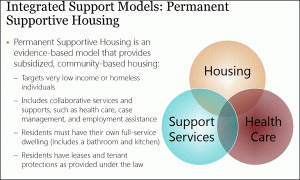Here’s an article from Monica Oss of Open Minds about housing. Quoted are Community Access’ Cal Hedigan and Alysia Pascaris, who were present at Open Minds’ recently held policy institute.
June 23, 2015 | Monica E. Oss
Housing is one of those “most critical” of social determinants of health (see The Social Service Factor In The Health Care Value Equation and Making The Connection Between Health Care Costs & Social Support Services). Yet, for a segment of the population, lack of housing is a pressing issue and deters pursuing other health management strategies. The question? How to finance and manage supportive housing initiatives?
And, regardless of the model, executives from three leading organization in the housing space – Luke Crabtree, Chief Executive Officer, Project Transition; Cal Hedigan, Deputy CEO, and Alysia Pascaris, Deputy CEO, Community Access; and Jeff Kirschner, Executive Vice President, Greater Cincinnati Behavioral Health Services – all agreed that there are some fundamental principles in the housing space during our session, Housing & Health Care: Emerging Models To Provide Housing & Treatment Services For Complex Consumers, at The 2015 OPEN MINDS Strategy & Innovation Institute. Some of these principles included seeking to integrate the previously homeless individuals into the community, and housing them alongside other community members; supporting self-determination; pursuing as many funding streams as possible; requiring the use of data; and using partnerships.
A couple big issues were discussed in the session. The first, should organizations that provide supportive housing programs own or lease housing stock? The answer was “it depends.” And what it depends on is the real estate market. For example, in the New York market, Community Access owns and operates its housing, due to the overall shortage of affordable housing. Also, the New York team said that they had challenges with getting “alignment” with the priorities of external landlords, and they have created a separate division of the organization to manage the landlord tenant function – separate from the team that provides the support services.
In the Cincinnati market, on the other hand, there is wider availability of housing stock, making leasing the most effective option (consumers lease directly from landlords). To address this, the Cincinnati organization created the position of housing broker. This position starts by recruiting an experienced care manager who has worked with consumers, and who has the ability to get out into the community, learn about available housing, and get to know the private landlords.
Another issue was the balance between the scale of supportive housing initiatives and compliance with the Olmstead Act. Ms. Hedigan of Community Access spoke to the need of housing sites of 120+ occupants just to achieve the economies of scale needed for sound fiscal management. For organizations that do not manage their own units, such as Greater Cincinnati Behavioral Health Services and Project Transition, scale is less of an issue. But the density of consumers in a geographic area does affect the cost of support services. Either way, all three organizations grapple with the interpretation of Olmsted, as it’s generally accepted that between 50% and 60% of the population of a supported housing building could be citizens with special needs.
And my final takeaway was the interesting recommendation that combining Assertive Community Treatment (ACT) programs (see Magellan’s Shift To Gainsharing and A Look At P4P From The Ground Level) and Housing First (see What Is “Housing First”? and ‘Housing First’ Models Gain Support) creates an optimal supported housing model.
The issue of housing will continue to be an issue for organizations that are managing care of consumers with complex support needs – if you are on an executive team operating in this space, don’t expect it to be off the radar any time soon.

